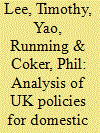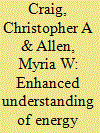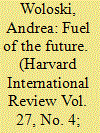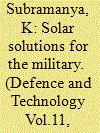| Srl | Item |
| 1 |
ID:
127907


|
|
|
|
|
| Publication |
2014.
|
| Summary/Abstract |
This paper introduces a new agent-based model, which incorporates the actions of individual homeowners in a long-term domestic stock model, and details how it was applied in energy policy analysis. The results indicate that current policies are likely to fall significantly short of the 80% target and suggest that current subsidy levels need re-examining. In the model, current subsidy levels appear to offer too much support to some technologies, which in turn leads to the suppression of other technologies that have a greater energy saving potential. The model can be used by policy makers to develop further scenarios to find alternative, more effective, sets of policy measures. The model is currently limited to the owner-occupied stock in England, although it can be expanded, subject to the availability of data.
|
|
|
|
|
|
|
|
|
|
|
|
|
|
|
|
| 2 |
ID:
118096


|
|
|
| 3 |
ID:
127903


|
|
|
|
|
| Publication |
2014.
|
| Summary/Abstract |
This study explores factors related to energy consumers' perceptions of government subsidies for utility provided energy efficiency (EE) programs and for utility providers' use of more clean/alternative energy sources. Demographic factors, attitudes, planned purchases, and perceptions of utility provider motives in relation to governmental and utility provider EE initiatives (i.e. providing discounts and coupons for CFL bulbs), plus the influence of gain- and loss-framed messages are investigated. Over 2000 respondents completed a 16 item phone survey. Hierarchical regression explained 38% of the variance in reactions regarding government subsidies of the cost of utility provided EE programs and 43% of the variance in perceptions involving whether utility companies should use of more clean or alternative forms of energy. Gender and party differences emerged. Loss-framed messages were more important when the issue was government subsidies. Both gain- and loss-framed messages were important when clean/alternative energy was the issue.
|
|
|
|
|
|
|
|
|
|
|
|
|
|
|
|
| 4 |
ID:
070792


|
|
|
| 5 |
ID:
129364


|
|
|
|
|
| Publication |
2012.
|
| Summary/Abstract |
With the need for alternative sources of energy on the rise, especially in recent years, it is no surprise that the defence sector can be one of the largest consumer of solar power in India.
|
|
|
|
|
|
|
|
|
|
|
|
|
|
|
|